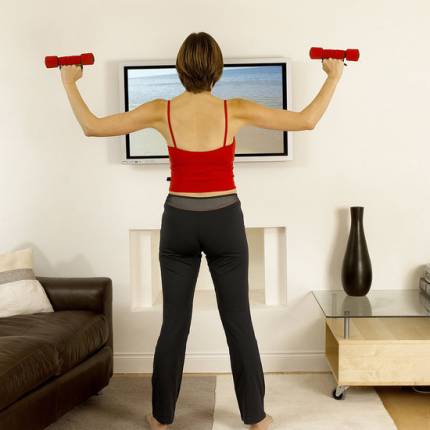
Walk into any gym and you will commonly see men all busy in the weight room while women are working hard on the cardio equipment. Why do so many women prefer cardio over weight training? Because of the several popular myths and fears surrounding weight training, most women hesitate to include it in their regular exercise routine.
A study by the Centers for Disease Control in 2004 points out that only 17.7% of women lifted weights as compared to 21.9% of men. The fact is that women of all ages can vastly improve their metabolism, looks and stamina while reducing their chances of cardiovascular disease, high blood pressure and high cholesterol through regular weight training. Scroll down to debunk the nine most popular weight training myths for women.
First myth: Weight training makes women bulky and masculine

Debunking the myth:
This is the most common misconception that women have when it comes to weight training. Michael Wood, an exercise physiologist and director of Sports Performance Group at Cambridge says this is physiologically impossible. Why? Because women can never produce ultra-high levels of testosterone, the main hormone responsible for increasing the muscle size. Professional female bodybuilders consume steroids that are synthetic testosterone to build a high degree of muscularity. Women who practice weight training consistently without the use of steroids achieve a firm and great looking body.
Second myth: Cardio alone is enough for women

Debunking the myth:
Practicing a cardio routine alone will offer some health benefits while eliminating others. Though cardio is a great way to burn calories efficiently, there is a risk of muscle tissue loss if you do not train on weights. Weight training on the other hand improves muscle mass, thereby increasing the number of calories burned at rest. The National Strength and Conditioning Association say that weight training improves bone density better than cardio exercise alone. Increased strength that is provided by weight training makes day to day activities such as lifting and moving objects and other household chores a breeze.
Third myth: Women need different weight training than men

Debunking the myth:
There is no gender-specific exercise! Men and women have the same muscles, so it makes sense that they need the same exercises too. But women are often encouraged to work on light weights using slow movements out of a fear that high intense workout will cause injury. However, there is no evidence that suggests that women are more probable to be injured while weight training than men. Both men and women need to follow proper precautions during weight training in order to reduce the risk of injuries.
Fourth myth: If weight training is stopped, then muscles will turn into fat

Debunking the myth:
Muscles and fats are two entirely different types of tissues, and can never turn into the other at any point of time. If you discontinue your weight training routine, then you will start to lose muscles due to a slow metabolism caused by inactivity. Less of muscles simply means more room for fat. This gives a false impression that your muscles are being turned into fats, while what is actually happening is that muscles are being lost and fat is being stored by your body.
Fifth myth: Women need to eat a high amount of protein for weight training

Debunking the myth:
The recommended daily allowance of protein is 0.8 grams per kilogram of body weight. This holds true for women who follow a weight training routine as well. The amount is only slightly higher, at around 1 gram per kilogram for female bodybuilders. For example, a woman who weighs 60 kg will require anywhere between 47-60 g of protein per day if she is trying to build her muscle mass with intense weight training. Therefore, women who follow a light to moderate weight training program do not require any extra protein. Apart from protein, women also require healthy carbs such as fruits, veggies and whole grains for sustaining a weight training routine.
Sixth myth: Repetitions of the same weight training exercise is necessary for better results

Debunking the myth:
Repetitions are good only to build muscular endurance. But if you are aiming to lose body fat to achieve a lean look, then you must increase the weight you train on by at least 5 percent after you complete 8-10 repetitions of an exercise. This is because the only way to see maximum results is by training on a challenging weight, which is a weight that is heavy enough so that you can barely train on for more than 10 times in a row.
Seventh myth: You need to work every muscle individually in weight training

Debunking the myth:
It is totally unnecessary to work each of your 600 muscles individually in weight training. Women get faster and better results by performing compound moves such as squats, pushups, lunges and dips that target multiple joints in the body while weight training. This is because compound moves burn much more calories than individual moves such as biceps curl or leg extension. Another advantage is that compound moves are similar to the activities you perform in your day to day life such as vacuuming or hauling grocery bags, so the chances of pulling a muscle at any time is minimal.
Eighth myth: Weight training is not recommended for old women

Debunking the myth:
The truth is that no one is too old to train on weights. In fact, studies show that women even in their nineties can derive great benefits from a regular weight training program. Research tells us that women lose 3 to 5 percent of muscle mass beyond the age of 40, so it becomes essential for senior women to practice a weight training routine consistently to prevent loss of muscle mass.
Ninth myth: Weight training can be done only in a gym

Debunking the myth:
Wrong! You can practice an effective weight training routine in the comfort of your own home with free weights. Women can easily do squats, bicep curls, triceps extensions, lunges, chess press, shoulder press, dead lifts and bent over rows right in their living room while watching TV. Any exercise that is performed on a weight machine in the gym can be done using dumbbells weighing 3, 5 and 10 lb. at home.
If you wish to know more about health related course, visit Training.DrPrem.com to explore your preferred course.


